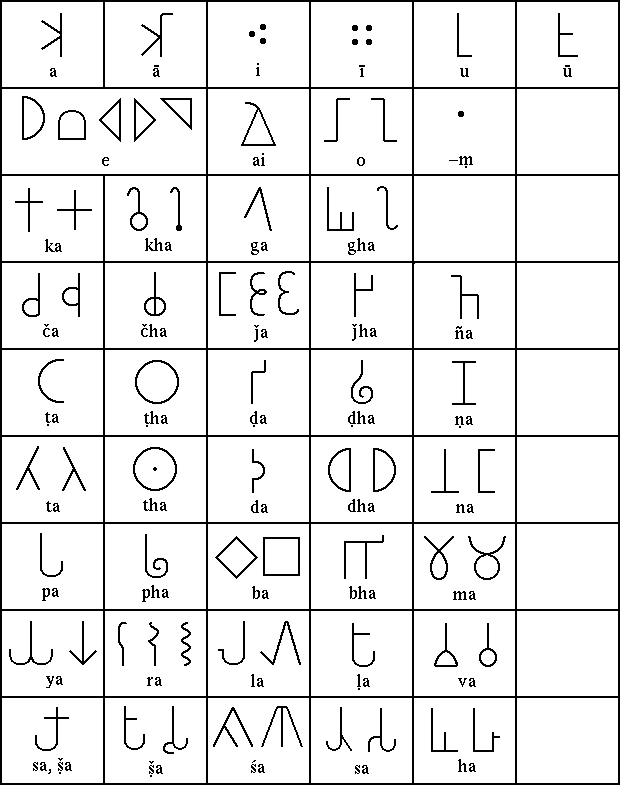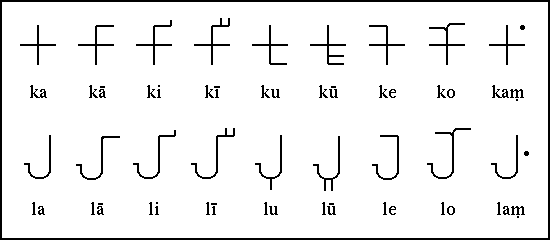THE SANSKRIT LANGUAGE
A BRIEF PRESENTATION
BY
N.KRISHNASWAMY
Sanskrit is
unique among the world's
languages for at least three reasons.
First, it is among the oldest,
if not indeed the oldest.
As the language of
India's scriptures, the Vedas, it
goes back to 3000 BC
according to some scholars,
and to more remote antiquity,
according to Indian tradition.
Secondly, it possessed a scientific linguistic
structure, extensive vocabulary and
expressive power that produced
from the earliest times, a literature of an
extraordinary range, depth and volume
not excelled by any other
culture of the world. And
thirdly, it has largely retained
a consistencyand continuity
of structure and content
through successive millenia despite being maintained
almostwholly by being
memorised and transmitted orally
by successive generations.
Only one transition
in structure and content is recognised
in the historical development of
the language . This is attributed to
the grammarian Panini who,
around the 5th Century BC,
perfected its grammatical structure.
Thename Sanskrit,
indeed means perfected, in contradistinction
toPrakrit, which means
natural, and refers to the natural unrefined, colloquial usage
of all other
local dialects of the time. Sanskrit before and after Panini
are referred to as Vedic and Classical
Sanskrit respectively.
The earliest known
form of Indian writing (barring
the earlier Indus Valley script
which is yet to be deciphered)
was the Brahmi script, and
it's earliest known use dates back
to the time of Buddha in the 5th Century BC.
This was used by the
prevailing languages including Sanskrit which was used
by the followers of the Vedic religion, and Pali
which was used
in the Buddhist and Jain
scriptures. One of the earliest inscriptions in this script known to us is
the Rock inscription of
Asoka at Girnar in Gujarat,
dating back to 257 BC. Modern India owes
an enormous debt of gratitude
tothe brilliant
English scholar James Prinsep (1799
- 1840) for completely deciphering
the Brahmi script as seen
in this table, and also establishing
how the scripts of most
of the Indian languages
of today are derived from
this ancient Brahmi andit's local variants.
The following images show
the complete Brahmi alphabet as it is known today :


The characters of the
Nagari script as we know it today
got standardised for Sanskrit
from around the 3rd Century AD
It is interesting to see
from the table below, how
these characters were represented about six centuries earlier
in Brahmi, in the Rock
inscription of Asoka at Girnar.
DIACRITISED ENGLISH - DEVANAGARI - BRAHMI
TABLE
VOWELS :
a ˜
i Ÿ u ¨
¾ ai Ì au aÐ a×
A Aa
# $ % ^
@ @e Aae AaE A<
A>
 ---
--- --
--  -------
------- -
- ---------
---------  -
-  -
- 
CONSONANTS
:
Gutturals :--------
ka kha ga gha ða(originating
from the throat)
---------------------
k o g " '
--------------------
Palatals :-----------
ca cha ja jhaña(originating
from the palate)
---------------------
c D j H |
--------------------
Cerebrals :---------
÷a ÷ha ýa ýhaõa
(originating from the roof of the mouth)
----------------------
q Q f F [
--------------------
Dentals :-----------
ta tha da dhana(originating from
the teeth)
----------------------
t w d x n
---------------------
Labials :------------
pa-pha-ba-bha-ma(originating from
the lips)
----------------------
p ) b - m
---------------------
Semi-vowels :------
ya ra la va ha(originating
from different points)
---------------------
y r l v h
---------------------
Sibilants : ----------
þa sa ÿa
(originating as a hissing sound)
----------------------
z s ;
---------------------
What is
immediately striking in this
table is the remarkable
phonetic structure of the Sanskrit
language and how it's comprehensive
range of phonetic values
had largely been well established
on a scientific basis even
at the time of it's
first known use of written
representation through the Brahmi script.
The vowel and consonant sets,
with the vowels sounded mainly
by the breath alone, and
the consonants scientifically grouped
according to where or how
their sounds originated in the mouth, together
with their aspirate variants and
the sibilants, showa
remarkable insight into phonetic - based
linguistic principles that would
suggest evolution over several
prior millenia.
The related text of Asoka's
Rock Inscription at Girnar can be seen by following
the link given below. How close it is to the Sanskrit of those times, will
be readily recognizable. The textual content, of course, has it's own
charm, evidencingthe extraordinary concern
of one of India's greatest kings for the welfare of man
and animal alike.
CLICK HERE TO SEE ORIGINAL TEXT OF
ASOKA'S INSCRIPTION
Not less
remarkable in the development of Sanskrit was it's streamlining
effectedby Panini
in the 5th Century BC, by way of
standardising the rulesof how
composite syllables and composite words
were to be formed, establishing a comprehensive
vocabulary of word roots, and establishing a
scientific grammar of extraordinary excellence,
setting out the rules of word usagein
the language. The standard compilations
of the Dhatu Patha (Verb roots), the
Sabda Kosha (Noun forms) and the Amara Kosha (Thesaurus-Dictionary)
along with the traditional disciplines like Siksha (Phonetics),
Chandas (Metric composition), Nirukta (Etymology), etc. provided a comprehensive
rule base for
correct usage, not excelled in any other language.
All these have enabled the
language to yield a phenomenal
volume,range and
depth of literature on
every conceivable subject, while
ensuring that the language
retained it's pristine purity
over themillenia.
Our other presentations in
this Website provide
impressive examples of this. This
presentation howeveris
limited only to
providing a brief overview
of the language and it's basic features, which
has enabled it to stand
the test of time.
RETURN TO INDEX OF LITERARY &
OTHER WORKS


